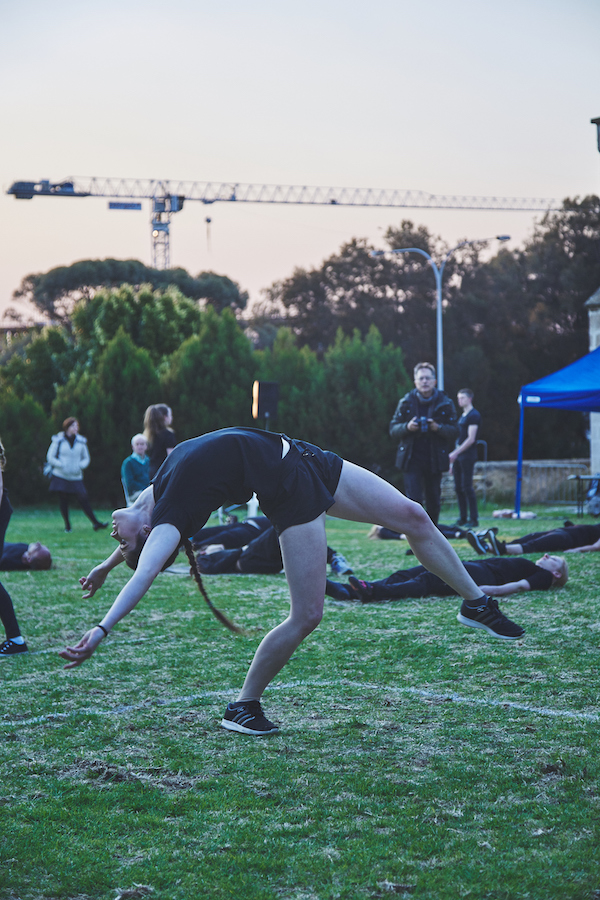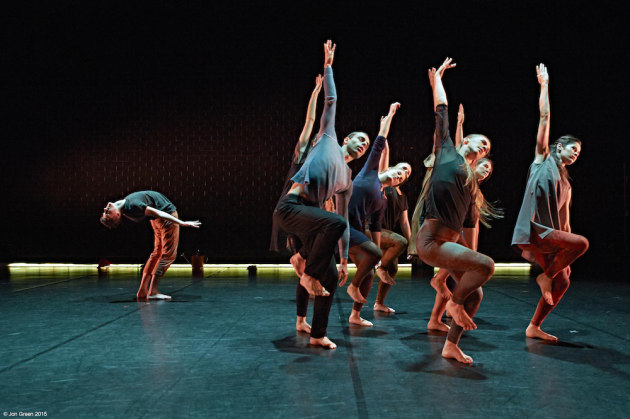Nina Levy talks to the WA Academy of Performing Arts’s Molly Tipping to find out how you can develop your core stability and mobility.
This is the first in a series of articles providing tips and advice for improving your contemporary dance technique. The second part is in the February/March '18 issue of Dance Australia.
Part 1: A supple torso
LAST year I had the pleasure of seeing Alvin Ailey American Dance Theater at Sadler’s Wells in London. The dancers were simply gorgeous to watch; their luscious, rippling torsos apparently boneless. My favourite contemporary dancers all have those gloriously articulate spines. But while they may appear to be all about looseness and flexibility, that ability to bend, roll and ripple one’s torso requires strength as much as flexibility.
Like so many skills in dance, the best contemporary dancers make it look easy, but actually achieving that fluidity through the spine can be challenging for young dancers, especially those who have come from a predominantly classical training background.
So how can a dancer improve his or her ability to move through the spine? I spoke to Molly Tipping, a Feldenkrais practitioner and Pilates instructor who teaches dance students at the Western Australian Academy of Performing Arts (WAAPA), to find out.
It’s about being stable… but also mobile
While all dance styles require core stability, contemporary dance requires more than just stability of the trunk, says Tipping. “Core stability requirements for contemporary dance are much more complex than other styles. In ballet you can brace the core. You can create an almost immoveable trunk, to a certain extent, or a slightly moveable trunk, but that doesn’t work in contemporary dance.”
What is core stability used for in contemporary dance?
“Contemporary dance uses core stability in the same ways as every dance style: for alignment, balance, co-ordination, precision and centring,” explains Tipping. “But in contemporary dance we also use core stability for things like spirals, suspensions, falling, off-balance turns and partnering work (both men and women). Floor work also requires really good core strength, as does moving from the floor through the mid-level, through the upper level… and some contemporary dance styles are really athletic. They have huge power output in terms of direction in space, speed, and you need a really strong, agile core to deal with the choreography.”
“In contemporary dance we also use core stability for things like spirals, suspensions, falling, off-balance turns and partnering.”
I have a strong core from ballet – will this transfer to contemporary technique?
“Core stability in contemporary dance is much more nuanced and complex than ballet,” replies Tipping. “While ballet certainly has high demands for core stability, contemporary dance is more specialised and style-specific. Certain styles are really athletic and you’re going to need an athletic use of the core. Some styles are very lyrical and they’re going to require this soft, fluid use of the core. ‘Core dexterity’, ‘core control’ and ‘core mobility’ are better terms to think about in relation to contemporary dance, because ‘core stability’ implies lack of movement and in contemporary dance you have to have movement.
“In ballet you can brace the core like a cylinder. In contemporary dance that doesn’t work for many exercises. For contemporary, a more effective way of thinking about the core is that it’s like an anchor from which the limbs initiate and to which they return. That is a more potent and specific image for contemporary dance – a radiating core connection, rather than a cylindrical core connection. “Because classically-trained dancers use their core like a cylinder, when they transfer into contemporary dance they can struggle to get in and out of floor, struggle with flow, sequencing. Or when they give up the idea of bracing they suddenly have way too much mobility and no control. So they need to have two ideas about the core – one that works in ballet, and one that works in contemporary.

What do you recommend to build core stability in contemporary dancers?
“In a younger dancer, or in a dancer who has lots of mobility, I would recommend Pilates, yoga, Bartenieff fundamentals and floor barre, because these are a little simpler, they have patterns and shapes that are easy to grasp,” says Tipping. “In someone who has a lot of mobility, they need to get more strength and minimise excessive movement through their middle. A dancer like that could stick with Pilates for many years.
“A lovely middle ground, that is an excellent step up or shift from Pilates, would be something like Gyrokinesis, Gyrotonics or the Garuda Method. These have more spiralling patterns and rotational movements that demand good control of the core but they’re not as simple as Pilates. These systems work really well for someone who needs a little more co-ordination or strength of the core or, if they come from ballet and they’re used to doing bracing techniques, to move away from the simple control of Pilates.
“If you’ve been dancing for quite a while and have good understanding of the basics, things like aerial yoga, or Ido Portal (which is an Israeli functional movement system) are great. Calisthenics or gymnastics systems have become more and more popular lately and you have all these functional gyms, which do quite a lot of these kinds of challenging work. Aerial yoga’s great. There are lots of different aerial yoga and partner based yoga studios around. As long as you are good with your basics, that’s going to take you to next level.”
Bear in mind
When it comes to spinal mobility in contemporary dance, says Tipping, it’s important to know that your strength, rather than flexibility, that will unlock your spine’s full potential for movement. Too often, she notes, she sees dancers trying to stretch their spines in ways that work against the spine’s natural curves. “Trying to stretch your spine in opposition to its curves will weaken those joint structures,” she warns. “Dancers need to understand which parts of the spine are designed for flexion (contraction or bending forwards) and which are made for extension (arching backwards).
“Mobility without strength is fertile ground for injury.”
Glossary of terms
Bartenieff Fundamentals: A set of movement principals and corrective exercises developed by Irmgard Bartenieff that apply the movement theory of Rudolf Laban to the human body.
Body Mind Centering (BMC): Developed by Bonnie Bainbridge Cohen, BMC is an approach to movement that is based on the embodiment and application of anatomical, physiological, psychophysical and developmental principles, utilising body, touch, voice and mind.
The Feldenkrais Method: A somatic and movement education system that develops self awareness and awakens the nervous system’s innate capacity to learn; improving quality of life through better movement, posture, breathing and emotional regulation.
Garuda Method: Combines elements of yoga, Pilates and ballet to develop poise, control and a leaner, more resilient body.
Gyrokinesis and Gyrotonics: Movement methods that open energy pathways, stimulate the nervous system, increase range of motion and create functional strength through rhythmic, flowing movement sequences. They coordinate movement, breath and mental focus.
Ido Portal: A movement-based practice that integrates developmental movement patterns, functional movement, capoeira
and improvisation.
Top: Core stability requirements for contemporary dance are much more nuanced and complex than other styles. Pictured are students from the Western Australian Academy of Performing Arts in 2015’s Pulse. Photo: Jon Green.
This article was first published in the December '17/January '18 issue of Dance Australia. It is the first instalment of a five-part series on improving contemporary technique. Keep your eye out for part two in the February/March issue of Dance Australia, OUT SOON! Available at your favourite magazine retailer, subscribe here, or purchase an online copy via the Dance Australia website.



